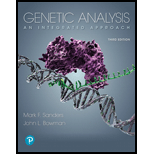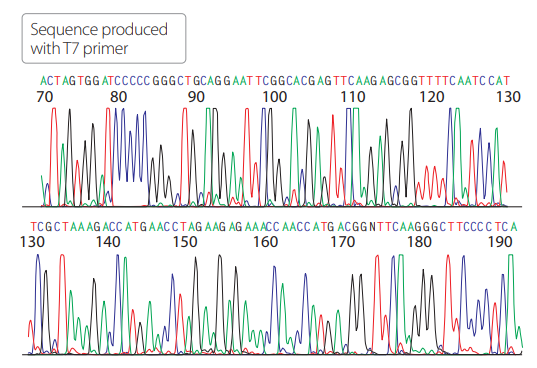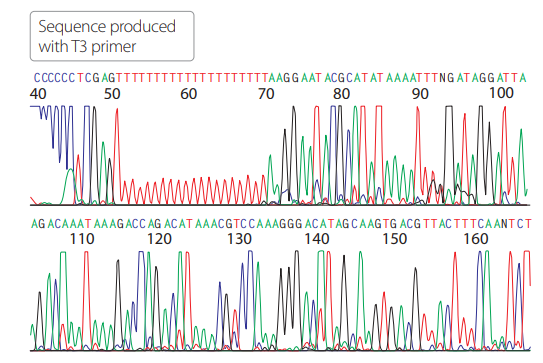
Concept explainers
You have isolated another cDNA clone of the CRABS CLAW gene from a cDNA library constructed in the vector shown in Problem
Which of the sequence shown below represents the
Will the long stretch of T residues in the T


Can you identify which sequences are derived from the vector (specifically the MCS) and which sequences are derived from the cDNA clone?
Can you identify the start of the coding region in the
Want to see the full answer?
Check out a sample textbook solution
Chapter 15 Solutions
Genetic Analysis: An Integrated Approach (3rd Edition)
- P You are studying a population of 100 flowers that has two alleles at a locus for flower color, blue (B) and green (G). There are 15 individuals with the BB genotype, 70 individuals with the BG genotype, and 15 individuals with the GG genotype. (a) What are the allele frequencies of B and G in the starting population? Show your calculations. (2 pts) (b) Is this population in Hardy-Weinberg equilibrium? Show your calculations. (3 pts) 12pt v Paragraph BIU UA AV & VT2V f CO Varrow_forwardIn a natural population of outbreeding plants, the variance of the total number of seeds per plant is 16. From the natural population, 20 plants are taken into the laboratory and developed into separate true-breeding lines by self- fertilization-with selection for high, low, or medium number of seeds-for 10 generations. The average variance in the tenth generation in each of the 20 sets is about equal and averages 5.8 across all the sets. Estimate the broad-sense heritability for seed number in this population. (4 pts) 12pt v Paragraph BIUA V V T² v B ① O wordsarrow_forwardIn a natural population of outbreeding plants, the variance of the total number of seeds per plant is 16. From the natural population, 20 plants are taken into the laboratory and developed into separate true-breeding lines by self- fertilization-with selection for high, low, or medium number of seeds-for 10 generations. The average variance in the tenth generation in each of the 20 sets is about equal and averages 5.8 across all the sets. Estimate the broad-sense heritability for seed number in this population. (4 pts) 12pt v Paragraph BI DI T² v ✓ B°arrow_forward
- Question 1 In a population of Jackalopes (pictured below), horn length will vary between 0.5 and 2 feet, with the mean length somewhere around 1.05 feet. You pick Jackalopes that have horn lengths around 1.75 feet to breed as this appears to be the optimal length for battling other Jackalopes for food. After a round of breeding, you measure the offsprings' mean horn length is 1.67. What is the heritability of horns length (h2)? Is Jackalope horn length a heritable trait? (4 pts)? 12pt v Paragraph BIU A ✓arrow_forwardFrequency of allele A1 Question 2 The graph below shows results of two simulations, both depicting the rise in frequency of beneficial allele in a population of infinite size. The selection coefficient and the starting frequency are the same, but in one simulation the beneficial allele is dominant and in the other it is recessive. Neither allele is fixed by 500 generations. 1.0 1 0.8 0.6 0.4 2 0.2 0 0 100 200 300 400 500 Generation (a) Which simulation shows results for a dominant and which shows results for a recessive allele? How can you tell? (4 pts) (b) Neither of the alleles reaches fixation by 500 generations. If given enough time, will both of these alleles reach fixation in the population? Why or why not? (3 pts) 12pt Paragraph BIU AT2v Varrow_forwardQuestion 14 The relative fitnesses of three genotypes are WA/A= 1.0, WA/a = 0.7, and Wa/a = 0.3. If the population starts at the allele frequency p = 0.5, what is the value of p in the next generation? (3 pts) 12pt v V Paragraph B I U D V T² v V V p O words <arrow_forward
- According to a recent study, 1 out of 50,000 people will be diagnosed with cystic fibrosis. Cystic fibrosis can be caused by a mutant form of the CFTR gene (dominant gene symbol is F and mutant is f). A. Using the rate of incidence above, what is the frequency of carriers of the cystic fibrosis allele for CFTR in the US? (3 pts) B. In a clinical study, 400 people from the population mentioned in (A.) were genotyped for BRCA1 Listed below are the results. Are these results in Hardy- Weinberg equilibrium? Use Chi Square to show whether or not they are. (3 pts) BRCA1 genotype # of women 390 BB Bb bb 10 0 12pt Paragraph L BIUAV V T² v Varrow_forwardOutline a method for using apomixis to maintain feminized CannabisAssume apomixis is controlled by a single dominant gene. You can choose the type of apomixis: obligate or facultative, gametophytic or sporophytic. Discuss advantages and disadvantages of your proposed method.arrow_forwardKinetics: One-Compartment First-Order Absorption 1. In vivo testing provides valuable insight into a drug’s kinetics. Assessing drug kinetics following multiple routes of administration provides greater insight than a single route of administration alone. The following data was collected in 250-g rats following bolus IV, oral (PO), and intraperitoneal (ip) administration. Using this data and set of graphs, determine:(calculate for each variable) (a) k, C0, V, and AUC* for the bolus iv data (b) k, ka, B1, and AUC* for the po data c) k, ka, B1, and AUC* for the ip data (d) relative bioavailability for po vs ip, Fpo/Fip (e)absolute ip bioavailability, Fip (f) absolute po bioavailability, Fpoarrow_forward
- 3. A promising new drug is being evaluated in human trials. Based on preliminary human tests, this drug is most effective when plasma levels exceed 30 mg/L. Measurements from preliminary tests indicate the following human pharmacokinetic parameter values: t1/2,elim = 4.6hr, t1/2,abs = 0.34hr, VD = 0.29 L/kg, Foral = 72%. Based on these parameters, estimate the following if a 49 kg woman were to receive a 1000mg oral dose of this drug: (a) Estimate the plasma concentration of the drug at 1hr, 6 hr, and 20hr after taking the drug ( Concentration estimate) (b) Estimate the time for maximum plasma concentration (tmax). (c) Estimate the maximum plasma concentration (Cmax). (d) Estimate the time at which the plasma level first rises above 30 mg/L. (Note this is a trial and error problem where you must guess a time, plug it into the concentration equation, and determine if it is close to 30 mg/L. Hint: based on part (a) it should be apparent that the answer is less than 1hr.) (e)…arrow_forwardList substitutions in your diet you could make to improve it based on what you know now about a balanced diet. For instance, if you like to drink soda, you might substitute skim milk or water for some of the soft drinks you consumed. List the item you wish to replace with the new item and what you hope to accomplish with that substitution. Be sure to choose foods you know that you'd enjoy and you consider more "healthful." If you feel your diet is already balanced, describe how you accomplish your balanced intake and when you began eating this way.arrow_forwardWhich single food item contained you ate for the 3 days with the most sodium?arrow_forward
 Human Heredity: Principles and Issues (MindTap Co...BiologyISBN:9781305251052Author:Michael CummingsPublisher:Cengage Learning
Human Heredity: Principles and Issues (MindTap Co...BiologyISBN:9781305251052Author:Michael CummingsPublisher:Cengage Learning Biology Today and Tomorrow without Physiology (Mi...BiologyISBN:9781305117396Author:Cecie Starr, Christine Evers, Lisa StarrPublisher:Cengage Learning
Biology Today and Tomorrow without Physiology (Mi...BiologyISBN:9781305117396Author:Cecie Starr, Christine Evers, Lisa StarrPublisher:Cengage Learning Biology: The Dynamic Science (MindTap Course List)BiologyISBN:9781305389892Author:Peter J. Russell, Paul E. Hertz, Beverly McMillanPublisher:Cengage Learning
Biology: The Dynamic Science (MindTap Course List)BiologyISBN:9781305389892Author:Peter J. Russell, Paul E. Hertz, Beverly McMillanPublisher:Cengage Learning BiochemistryBiochemistryISBN:9781305577206Author:Reginald H. Garrett, Charles M. GrishamPublisher:Cengage LearningCase Studies In Health Information ManagementBiologyISBN:9781337676908Author:SCHNERINGPublisher:Cengage
BiochemistryBiochemistryISBN:9781305577206Author:Reginald H. Garrett, Charles M. GrishamPublisher:Cengage LearningCase Studies In Health Information ManagementBiologyISBN:9781337676908Author:SCHNERINGPublisher:Cengage Concepts of BiologyBiologyISBN:9781938168116Author:Samantha Fowler, Rebecca Roush, James WisePublisher:OpenStax College
Concepts of BiologyBiologyISBN:9781938168116Author:Samantha Fowler, Rebecca Roush, James WisePublisher:OpenStax College





